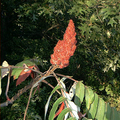 While I have never seen poison sumac at Smith Mountain Lake, that certainly does not eliminate the possibility that it exists somewhere out there in the campgrounds and more heavily forested areas. The key to identifying it seems to be its large alternate leaves usually with 9-13 entire (not toothed) leaflets on a reddish-colored stem. The leaflets are smooth and may be shiny on top.
While I have never seen poison sumac at Smith Mountain Lake, that certainly does not eliminate the possibility that it exists somewhere out there in the campgrounds and more heavily forested areas. The key to identifying it seems to be its large alternate leaves usually with 9-13 entire (not toothed) leaflets on a reddish-colored stem. The leaflets are smooth and may be shiny on top.
As with the other two members of the cashew family, poison sumac causes mild to severe contact dermatitis when one gets the urushiol oil of the plant on the skin. Many people confuse the poison sumac with the non-poisonous variety which is much more prolific and common. The next picture shows that the non-poisonous variety has much bigger leaves and pinkish-red pods.
If you have a bad rash from one of the poison plants it normally takes one to three weeks for symptoms to completely disappear – so follow these steps to make yourself a little more comfortable: Wash everything that came in contact with the plant (don’t forget pets) and put cool compresses on the itchy area. Add ground oatmeal (approximately 5 cups) or baking soda to a cool bath and soak for 15 to 30 minutes.
Add baking soda or Epsom salts to your bath, or make a paste of either of these and apply it to the rash. (Some people have found WHOLE milk compresses to be helpful.)
Opt for lotions containing calamine, alcohol, and zinc acetate; these will dry the blisters and help speed healing. Do not cover rash as open-air aids in healing.
(Thanks to Troy Evans and James Henderson for the use of their pictures.)
If you would like to identify a rash you picked up in the woods or while doing some backyard work, you can look at various rash pictures on Dr. Hardin’s website or at www.dermnet.com.

